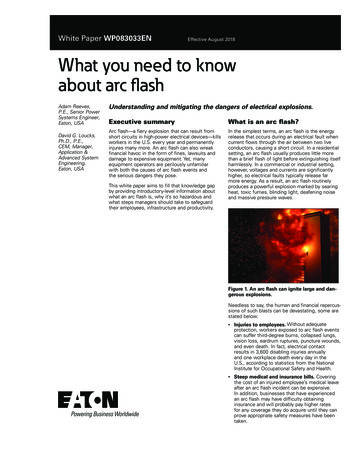
Transcription
White Paper WP083033ENEffective August 2018What you need to knowabout arc flashAdam Reeves,P.E., Senior PowerSystems Engineer,Eaton, USADavid G. Loucks,Ph.D., P.E.,CEM, Manager,Application &Advanced SystemEngineering,Eaton, USAUnderstanding and mitigating the dangers of electrical explosions.Executive summaryWhat is an arc flash?Arc flash—a fiery explosion that can result fromshort circuits in high-power electrical devices—killsworkers in the U.S. every year and permanentlyinjures many more. An arc flash can also wreakfinancial havoc in the form of fines, lawsuits anddamage to expensive equipment. Yet, manyequipment operators are perilously unfamiliarwith both the causes of arc flash events andthe serious dangers they pose.In the simplest terms, an arc flash is the energyrelease that occurs during an electrical fault whencurrent flows through the air between two liveconductors, causing a short circuit. In a residentialsetting, an arc flash usually produces little morethan a brief flash of light before extinguishing itselfharmlessly. In a commercial or industrial setting,however, voltages and currents are significantlyhigher, so electrical faults typically release farmore energy. As a result, an arc flash routinelyproduces a powerful explosion marked by searingheat, toxic fumes, blinding light, deafening noiseand massive pressure waves.This white paper aims to fill that knowledge gapby providing introductory-level information aboutwhat an arc flash is, why it’s so hazardous andwhat steps managers should take to safeguardtheir employees, infrastructure and productivity.Figure 1. An arc flash can ignite large and dangerous explosions.Needless to say, the human and financial repercussions of such blasts can be devastating, some arestated below: Injuries to employees. Without adequateprotection, workers exposed to arc flash eventscan suffer third-degree burns, collapsed lungs,vision loss, eardrum ruptures, puncture wounds,and even death. In fact, electrical contactresults in 3,600 disabling injuries annuallyand one workplace death every day in theU.S., according to statistics from the NationalInstitute for Occupational Safety and Health. Steep medical and insurance bills. Coveringthe cost of an injured employee’s medical leaveafter an arc flash incident can be expensive.In addition, businesses that have experiencedan arc flash may have difficulty obtaininginsurance and will probably pay higher ratesfor any coverage they do acquire until they canprove appropriate safety measures have beentaken.
White Paper WP083033ENWhat you need to know about arc flash August 2018 Exposure to fines and lawsuits. Any time employees die orare injured on the job, costly lawsuits are almost sure to follow.So, too, are fines from the Occupational Safety and HealthAdministration (OSHA). In fact, OSHA has been known to imposefines totaling millions of dollars after arc flash events, and haseven fined companies that have yet to suffer an event for failureto comply with arc flash safety standards. New compliance safetystandards were set by OSHA January 1, 2015, and put into effectApril 1, 2015. In addition to observing revised minimum approachdistances, employers now must estimate the incident heat energyof any electric-arc hazard to which a worker would be exposed,and must provide workers exposed to hazards from electric arcswith protective clothing and other protective equipment with anarc rating greater than or equal to the estimated heat energy.Through the OSHA general duty clause, companies can also befined for not complying with the requirements of NFPA-70E. Damage to equipment. Arc flash events are likely to severelydamage or permanently destroy any industrial, commercialand electrical equipment in their immediate vicinity. Smokecondensation can cause further harm to sensitive electricalequipment at greater distances. Additionally, should an arc flashtrigger the fire suppression system, valuable equipment will likelybe covered in water or thick flame-retardant foam. Delays and downtime. Companies sometimes must waitfor OSHA to complete an investigation before repairing arc flashrelated damage. That means organizations with insufficientlyredundant equipment can suffer hours, days or even weeks ofdowntime after an arc flash event. Impact on morale. Attracting and retaining qualified technicianscan be difficult if an arc flash incident causes current andprospective employees to view the facility as an unsafe placeto work.Arc flash mitigation strategiesGiven the significant dangers they pose, arc flash safety meritsserious attention. Here are some of the most effective strategiesfor reducing the frequency, severity and destruction of arcflash incidents.1.Perform an incident energy analysisPer NFPA-70E 130.5(G) an arc flash mitigation program must beupdated every 5 years with an incident energy analysis aimed atcalculating how much energy an arc flash could release at variouspoints along the power system. Incident energy is defined as theamount of energy, at a prescribed distance from the equipment,generated during an electrical arc event. It increases as the magnitudeof current flowing in the fault and clearing time increase. Incidentenergy from an arc flash event destroys electrical equipment, injurespersonnel and contributes to extended periods of downtime.Accuracy is essential with such measurements, so managers wholack direct and extensive experience with arc flash incident energyassessment should always seek assistance from a qualified powersystems engineer. The following standard assists with performingan incident energy analysis: IEEE 1584: Created by the Institute of Electrical and ElectronicsEngineers (IEEE), one of the world’s most respected technicalprofessional associations, IEEE 1584 offers guidance onquantifying potential arc flash incident energy levels.Upon completion of an arc flash incident energy analysis, companiesshould take the following steps:2EATON www.eaton.com2.Equip staff with appropriate personal protectiveequipment.Technicians should never come within range of a potential arc-flashhazard without wearing appropriate personal protective equipment(PPE), such as flame-resistant clothing, eye protection and gloves.PPE is available in varying degrees of strength, with varying degreesof protection. Electrical engineers and fire safety professionalsdeveloped a standard to help organizations determine how muchprotection their employees require:NFPA 70E: Produced by the National Fire Protection Association, anon-profit organization dedicated to fire, electrical, building and lifesafety, NFPA 70E defines thresholds for appropriate PPE based onthe severity of potential arc flash hazards. Drawing on the two standards above, as well as data collectedduring an arc flash incident energy analysis, organizations canaccurately determine their incident energy value at each locationin their system. Based on that value, organizations can choose thetype of PPE their employees should wear when working in arc flashdanger zones. Managers should also ensure that personnel from anyvendors or third-party service providers who perform maintenanceprocedures on their infrastructure wear appropriate PPE at all times.While arc flash safety standards such as IEEE 1584-2002 are extremely helpfultools, they contain an important gap at present: single-phase-to-ground faults.Though IEEE 1584-2002 provides energy calculations for three-phase arcingfaults, it offers no guidance on single-phase-to-ground faults, which according toIEEE 493-2007 Recommended Practice for the Design of Reliable Industrial andCommercial Power Systems, are between 7.8 (for junctions) and 73 times (forcable) more likely to occur than three-phase faults. Instead, the standard assumesthat ground faults will either self-extinguish or escalate into a three-phase fault.In truth, however, the additional energy released by single-phase ground faultsbefore they become three-phase faults can be substantial. This is becauseground faults tend to be lower current faults that require more time for upstreamprotective devices to clear, while higher current three-phase faults are clearedquickly. Since current IEEE 1584-2002 guidelines fail to take that additional energyinto account, they may significantly underestimate the amount of protectionexposed workers require. As previously mentioned, on January 1, 2015, OSHAimplemented a new safety standard that states employers generally must provideworkers exposed to hazards from electric arcs with protective clothing and otherprotective equipment with an arc rating greater than or equal to the estimatedheat energy.3.Post warning labelsTo ensure a facility’s employees are always aware of potential arcflash hazards, companies should place warning labels on any pieceof electrical equipment that poses an arc flash risk. They should alsomark arc flash hazard zones on the floor so workers not wearing PPEcan clearly see how far away from electrical equipment they muststand to avoid serious injury.Note that the NFPA 70E standard explicitly requires employers topost signage notifying employees of potential arc flash dangers.Organizations that ignore this directive dramatically increase theirchances of paying serious fines and losing expensive lawsuits afterarc flash incidents.
What you need to know about arc flash White Paper WP083033ENAugust 20184.WARNINGASHOCK & ARC FLASH HAZARDLocation: MAIN SWGRFLOAD SIDE of MAINDLINE SIDE of MAINReport#: TQS12345.1 Rev.0GIssued: JULY-201813’ 6” B ARC FLASH BOUNDARYCALCULATED INCIDENT ENERGY32 cal/cm AT 36” WORKING DISTANCE C23’ 10”EARC FLASH BOUNDARYCALCULATED INCIDENT ENERGY6 cal/cm AT 36” WORKING DISTANCE2480V Shock HazardMin. Glove Class: 00Limited Approach Boundary:3’ - 6”Restricted Approach Boundary:1’ - 0”Callouts for label:a.AThe owner of the electrical equipment is responsible forproviding arc flash warning labels which are required onelectrical equipment over 50V that could be accessed whileenergized.Bb.An arc flash boundary is the distance at which the incidentenergy equals 1.2 cal/cm2, and arc-rated PPE is required for anyemployee within the arc flash boundary.Cc.The working distance is the distance from a person’s face andchest to the prospective arc source. Typical working distances,primarily based on equipment type, are published in IEEEstandard 1584 and used in studies to perform the incidentenergy calculations.d.DWhile performing two sets of calculations for the load sideand the line side of the main breaker on specific equipmentis not specified in NFPA 70E, Eaton recommends making thisa standard practice to enhance productivity and safety forequipment that has adequate isolation of the main protectivedevice.- If the calculation is performed on the line side only, the entireswitchgear lineup may be incorrectly thought to have incidentenergy above 40 cal/cm2 and not able to be worked on whileenergized.- If the calculation is performed on the load side only, thecalculated incident energy value will be relatively low, puttingworkers on the line side in danger.Ee.Calculated incident energy is the amount of thermal energy(cal/cm2) at a distance from an electrical arc event andindicates the level of PPE required to protect workersFf.Nominal voltage, limited and restricted approach boundaries,and PPE glove rating are also displayed on the label to helpprotect workers from electric shock.Gg.Eaton’s labels display the arc flash study report number forreference.Implement an employee training programTo ensure personnel understand arc flash dangers and know howto avoid them, be sure every existing and newly hired employeereceives thorough arc flash safety training.5.Reduce available fault currentThough not applicable to environments protected by fuses andcurrent-limiting breakers, commercial, industrial and electricalequipment that use non-current limiting breakers (NCLBs) canreduce the amount of incident energy released during an arc flashby reducing the amount of available fault current. The following fourstrategies can help with NCLBs that significantly reduce availablefault current.Please note that reducing arc current can result in your devicestaking longer to trip, and therefore, have a higher incident energy.It’s important to implement the right solutions to help shortenfault clearing time.a. Operate with an open tie during maintenance. Maintainingdual electrical feeds helps increase the redundancy of theirpower supply, and hence the availability of their systems. Thedownside of this power architecture, however, is that it candouble the amount of current available when faults occur. Inmost cases, opening the tie between dual power feeds duringmaintenance procedures reduces arc flash dangers by cuttingavailable fault current in half.Of course, opening ties during maintenance also temporarilyrenders your power scheme less redundant, exposingequipment to heightened risk of failure. Given the devastatinghuman and financial toll an arc flash can take, mostorganizations consider that a tradeoff well worth making.b. Switch to smaller kVA and/or higher impedancetransformers. Consider using smaller continuously ratedtransformers and supporting infrequent overloads throughtemperature controlled fans. These fans can be orderedas optional equipment on both dry-type and liquid-filledtransformers. Another solution is to specify high temperatureliquid dielectric that supports higher continuous operatingtemperatures (75OC) and therefore can be safely loaded to ahigher level. In addition, or separately, higher impedance (Z)on the transformer can be specified. Note that in both cases(smaller transformer and/or higher impedance) load flow studiesshould be performed to ensure that voltage regulation limitsare maintained during load switching events, especially motorstarting.c. Employ high-resistance grounding. During ground faults,high-resistance grounding (HRG) systems provide a path forground current via a resistance that limits current magnitude.This dramatically reduces the size of line-to-ground faults andassociated arc flashes. HRG can be used on systems thatservice only three-phase loads. The U.S. National Electrical Codeprohibits using HRG on distribution systems serving loads thatare connected line-to-neutral, as are most servers. This limitsthe practicality of an HRG system to the portion of a facility’sdistribution system that typically only supplies motor loads.d. Current limiting devices. Connected in series and usedto reduce fault currents and to match impedance of parallelfeeders. For example, current limiting reactors can be used toreduce available short-circuit current, providing a reduction in thebolted and arcing fault current at downstream equipment.EATON www.eaton.com3
White Paper WP083033ENWhat you need to know about arc flash August 2018often found in switchgear, can take up to 4 cycles or 67 ms toclear a fault. Since incident energy is related to the magnitudeof current flowing in the fault and clearing time, the main circuitbreaker creates an impediment to achieve further reductionsin incident energy. Arc quenching switchgear, however, is ableto detect and contain an arc fault in less than 4 milliseconds,and can distinguish an arc fault from arcing that occurs duringnormal breaker operation. This is over 10 times faster thansystems that rely on a circuit breaker to clear a fault and yieldsa corresponding reduction in incident energy. The system worksby detecting the ignition of an arc inside the switchgear usingEaton’s arc flash relay and transferring it to the arc quenchingdevice where it is extinguished. Arc quenching switchgear hassuch a fast clearing time that it not only provides excellentpersonnel protection, but it also provides advanced equipmentprotection and it minimizes downtime due to arc flash events.Figure 2. A typical low-voltage motor control centershown above.6.NNote: When performing an incident energy analysis and implementingmitigation solutions, care must be taken to ensure the qualified workerunderstands the equipment and zone of protection. For example, aswitchboard main breaker equipped with maintenance mode may not besuitable to reduce the arc flash hazard if there is not adequate separation or barriers to prevent a load side fault from propagating to the lineside of the main breaker.Shorten clearing timeJust as a smaller arc flash releases less energy, so, too, does ashorter one. Here are five techniques for shortening arc flash eventsby decreasing fault clearance times:a. Utilize zone selective interlocking. Zone selectiveinterlocking (ZSI) is a protection scheme that uses an “inhibit”signal transmitted from downstream breakers that see a fault tothe next breaker upstream. The upstream breaker sees both thefault current and the inhibit signal, and therefore delays tripping,allowing the downstream breaker to clear the fault. Should afault occur between the downstream and upstream breaker,however, the downstream feeder doesn’t see the fault and willnot, therefore, send an inhibit signal to the upstream breaker.That causes the upstream breaker to bypass any intentional timedelay settings, significantly reducing arc flash incident energy.b. Implement a bus differential scheme. These are coordinatedzones of protection within an electrical system. When a faultoccurs within a given zone of protection (i.e., between the mainand feeder breakers), protective devices trip instantaneously,limiting arc flash durations while also confining arc flash damageto specific portions of your infrastructure. Bus differentialsystems are typically faster and more sensitive than ZSI butrequire additional current transformers and relaying equipment.This generally makes them harder to implement and moreexpensive.c. Deploy an Arc Flash Reduction Maintenance System.An Arc Flash Reduction Maintenance System shortens faultsby bypassing all time delays in the trip circuit any time currentexceeds a preset maximum. That enables faults to clear evenfaster than a circuit breaker’s “instantaneous” function makespossible. Technicians must manually enable circuits before doingmaintenance work and then disable them when that work iscomplete, employing familiar lockout/tagout procedures.d. Implement an Arc Flash Relay system. Arc faults are themost dangerous type of fault in low-voltage (LV) and mediumvoltage (MV) switchgear. An Arc Flash Relay system helpsimprove worker safety and maximize electrical assembly uptimeby combining current sensing with fiber optic light sensing toquickly detect and clear arc flash events. The system is designedto rapidly detect and clear even the most difficult forms ofarc flash events in LV and MV electrical assemblies. For moreinformation, refer to Eaton.com/EAFRe. Utilize Arc Quenching Switchgear. The total clearing time ofthe aforementioned systems includes the clearing time of theupstream circuit breaker. Low voltage power circuit breakers,4EATON www.eaton.comFigure 3. An Arc Flash Reduction Maintenance System shortensfault clearing times by bypassing time delays in the trip circuit.Actions to reduce arc flash riskAlthough the following actions will not reduce the calculated incidentenergy at a given location, these best practices will improve safetyby removing personnel from the arc flash hazard and reduce the riskof an arc flash event occurring in the first place.1.Adopt remote operationExecuting potentially dangerous proceduresremotely can shield personnel from injuries. Here are two ways tolimit the number of maintenance operations technicians must performwhile in range of arc flash blasts:a. Install remote monitoring, control and diagnostics software.Today’s sophisticated power management systems equipadministrators to perform many administrative tasks remotely.They also equip companies to remotely de-energize electricalequipment before staff approach it.b. Employ remote racking devices. Traditionally, technicians havehad to stand close to equipment with live, ele
energy above 40 cal/cm2 and not able to be worked on while energized. - If the calculation is performed on the load side only, the calculated incident energy value will be relatively low, putting workers on the line side in danger. e. Calculated incident energy is the amount of thermal energy











